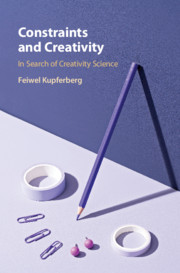Book contents
- Constraints and Creativity
- Constraints and Creativity
- Copyright page
- Contents
- Prolegomenon
- Preface
- Introduction
- Part I In Search of Creativity Science
- Part II Elaborating the Theoretical Model
- Chapter 2 Dimension I: Types of Constraints
- Chapter 3 Dimension II: Levels of Creativity
- Chapter 4 Dimension III: Getting It Right
- Chapter 5 Dimension IV: Protection of Vulnerable Versions
- Chapter 6 The Structure of Creative Processes
- Part III Conclusions: First Principles of Creativity Science
- References
- Index
Chapter 2 - Dimension I: Types of Constraints
from Part II - Elaborating the Theoretical Model
Published online by Cambridge University Press: 09 July 2021
- Constraints and Creativity
- Constraints and Creativity
- Copyright page
- Contents
- Prolegomenon
- Preface
- Introduction
- Part I In Search of Creativity Science
- Part II Elaborating the Theoretical Model
- Chapter 2 Dimension I: Types of Constraints
- Chapter 3 Dimension II: Levels of Creativity
- Chapter 4 Dimension III: Getting It Right
- Chapter 5 Dimension IV: Protection of Vulnerable Versions
- Chapter 6 The Structure of Creative Processes
- Part III Conclusions: First Principles of Creativity Science
- References
- Index
Summary
A constraint theory approach to creativity can conveniently be conceptualized in five different dimensions each of which captures some important way in which creativity is constrained. The five dimensions have been generated by the empirical patterns from comparing disciplines in the making. The first dimension is a list of the most important empirical types of constraints that emerge from theoretical sensitization of comparative data. All creative processes are constrained by physical constraints which was first noted by Hegel in his lectures on aesthetics and rediscovered be Elster. The important role of prototypes has been noticed by the art historian Ragnar Josephson and the literary theorist Johan Svedjedal. The role of knowledge constraints was noted by Randall Collins and elaborated by me. Rules of the game were discovered by Aristotle (theoretical, productive, practical knowledge) and rediscovered by Wittgenstein. Motivations have been at the core of sociopsychological and economic theories of creativity.
Keywords
- Type
- Chapter
- Information
- Constraints and CreativityIn Search of Creativity Science, pp. 51 - 84Publisher: Cambridge University PressPrint publication year: 2021

